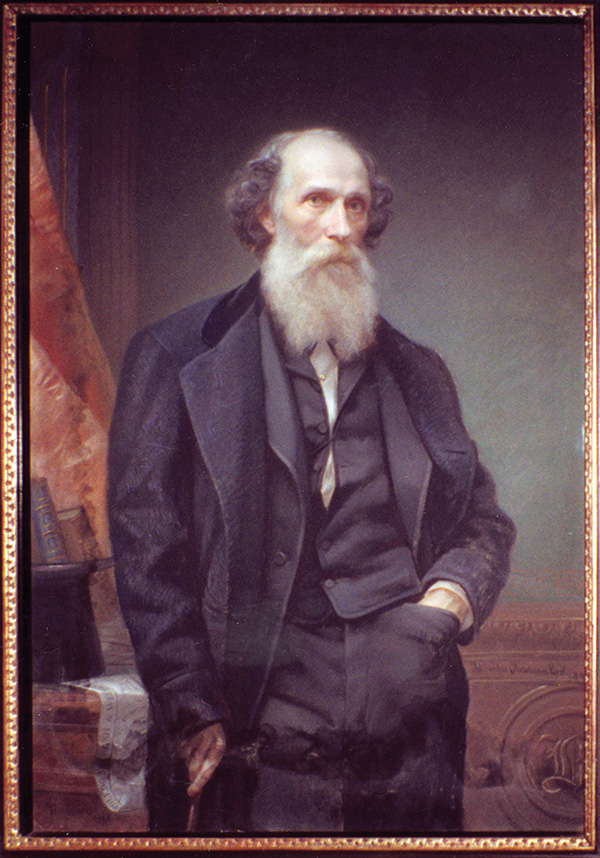In Review
 DANDELION DANDY: A University trustee and prominent Rochester businessman, Azariah Boody donated the land for the Prince Street Campus in 1853. The erstwhile pasture was fertile ground for dandelions, which became one of the University’s iconic emblems, and is still home to the Memorial Art Gallery.
DANDELION DANDY: A University trustee and prominent Rochester businessman, Azariah Boody donated the land for the Prince Street Campus in 1853. The erstwhile pasture was fertile ground for dandelions, which became one of the University’s iconic emblems, and is still home to the Memorial Art Gallery.Need History?
Do you have a question about University history? Email it to rochrev@rochester.edu. Please put “Ask the Archivist” in the subject line.
Azariah Boody was a University trustee from 1852 to 1865, and he donated eight acres of land that became the campus for the University’s second home on Prince Street. A portrait of Boody hangs in Rush Rhees Library: can you tell me anything about the artist and why the University has it?—Seymour Schwartz ’57M (Res), Distinguished Alumni Professor of Surgery, Rochester Medical Center
The name of Azariah Boody has reverberated throughout the University’s history. In the 1960s, Boody would become the namesake of a pre–Dandelion Day beer blast (“Boody’s Brawl”); in 1999, a secret society dedicated to enhancing school spirit claimed him. Our dandelion emblem is, of course, credited to his cows.
In 2000, to honor the University’s sesquicentennial, a gallery was created on the second floor of Rush Rhees Library to showcase paintings of University alumni, faculty, and staff, including US Senator Kenneth Keating, Class of 1919; Professor of Mathematics Isaac Quinby (1821–1891); and deans of the College for Women Annette Gardner Munro, Helen Bragdon, and Janet Clark.
Boody’s 4-foot-by-6-foot portrait is not an oil painting: it is a pastel with photographic roots. Two credits are discernible in the background of the artwork: “J. Dabour” and “Bogardus & Bendann Bros.”
John Dabour (1837–1905) was born in Smyrna, Turkey, trained in Paris, and emigrated to Baltimore. By the early 1870s, he was well enough established to receive commissions to paint oil portraits of Baltimore philanthropist Johns Hopkins and the first president of Johns Hopkins University, Daniel Coit Gilman (now in the collections of Johns Hopkins University), as well as other Baltimore luminaries.
“Probably the best authority on crayon and pastel portraits done from photographs is Mr. Dabour, who is with Sarony, Union Square,” advised The Art Interchange (May 22, 1886).
While Dabour’s skill was widely recognized, the fame of the photographers he credited was far greater.
Napoleon Sarony photographed Sarah Bernhardt, Oscar Wilde, Mark Twain, and Nikola Tesla. Abraham Bogardus was a prominent New York City daguerreotypist who established his business in 1846 and claimed four US presidents among his thousands of sitters. Daniel and David Bendann were based in Baltimore, and their company continues to this day as an art gallery. The partnership of Bogardus & Bendann Bros. lasted from 1871 to 1873, just long enough for their firm’s name to be included in the Boody portrait, which is dated 1872.
Acknowledging the renown, skill, and legal rights of the photographers was good business, and a natural progression from the days when engravers and lithographers would credit the original creators of the paintings and maps they reproduced. Boody’s photograph by Bogardus & Bendann may still exist, although it’s not in the University Archives.
In 1855, Boody sold his East Avenue property and moved to New York City. His attendance at meetings of the University’s trustees was irregular at best, and he resigned in 1865. The portrait shows Boody leaning on a walking stick, and on a table near his right elbow lies a piece of paper with the words “Toledo and Wabash,” representing the railroad company for which Boody served as president until 1873.
Azariah Boody died in 1885; his wife, Ambia, died in 1902. They are buried in Mount Hope Cemetery. As part of the dispersal of their estate, the portrait was given to the University by Boody’s nephew, Major General Elwell S. Otis, Class of 1858.
For many years, it was on display in Sibley Hall, and in 1922, the Campus newspaper reported that the glass protecting the picture was cracked; a multistanza poem celebrated the replacement in 1925:
Full many a moon in disregard
Did thy portrait languish;
Thy reverend mug a cracked pane marred,
Much to our mutual anguish . . .
After the Prince Street Campus was closed in 1955, the Boody portrait was kept in storage. It received much-needed conservation treatment in 1973 and was displayed at the Memorial Art Gallery in 1975 as part of an exhibit celebrating the University’s 125th anniversary. In recent years, an unseen hand has placed a bouquet of dandelions beneath the portrait as a birthday offering on March 4.
To learn more about Azariah Boody’s secrets, visit https://rbscp.lib.rochester.edu/blog/ATA-Fall2019.

